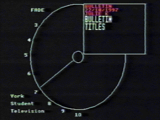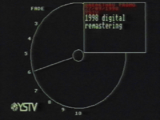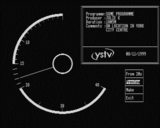Timeclock
Sometimes also referred to as a 'lead in' or 'leader clock', the timeclock is the countdown before a pre recorded programme starts on tape. It serves to give the VT operator some prior warning of where the start is such that it can be counted in to ensure the sound and vision mixers switch over at the right moment.
Pre 1998
In its first incarnation by unknown authorUnverified or incomplete information, running on a BBC Micro, the timeclock consisted of a large circle with overlapping text box for the producer and date(in red). Some double height text described the content.
A fixed 10 second countdown went black at 3s before finally swapping to a large white "Place the clip here" screen, which would subsequently be edited over. The change from white to black actually took about 3 frame periods, and you could see the screen clear on a frame accurate video player.
Technical
The timeclock software actually lived alongside an assortment of other graphics overlay software from pre-Commodore Amiga times, though these were infrequently used and the default menu option was always to create a timeclock.
Graphics from the BBC Micro could be overlayed by keying off the black background using the luma key in a vision mixer. The video system was genlocked to incoming video with an add on box labelled 'Beeblock' and an assortment of flying wires that entered through the otherwise unused network socket.
Post 1998
This was largely unchanged from the original, except that the words "York Student Television" in the bottom left hand corner were changed for a bitmapped Logo.
Revamp in 1999
By 1999 a number of shortcomings of the original timeclock had become apparent, in particular
- the screen was blank before the timeclock ran, and an more complex video path around the station meant that often the wrong route was chosen first time, so a second try was required
- only one timeclock ran then it returned to the menu system, so any second try required all of the fields to be retyped (see above!)
Using reference footage from a Secret Life of Machines video from Channel 4, a new timeclock generator was written by Rob Sprowson.
Technical
This included a preview mode which ran at high speed, options to start up to 40s from the start, a 1 frame flash at 15s, 'pips' at 3s, larger and clearer logo, and more intuitive editing.
It also dispensed with the double height text and red coloured writing, which due to the dubious colour output from a BBC Micro often lead to hard to read writing - even on a black and white monitor.
Now entirely written in BASIC, the generator could also be run on more recent machines than the graphics BBC Micro.
In 2007
One BBC Master in the station now contains the 1999 software, but burnt onto a permanent memory chip, removing the need for the unreliable 5.25" floppy drive.


